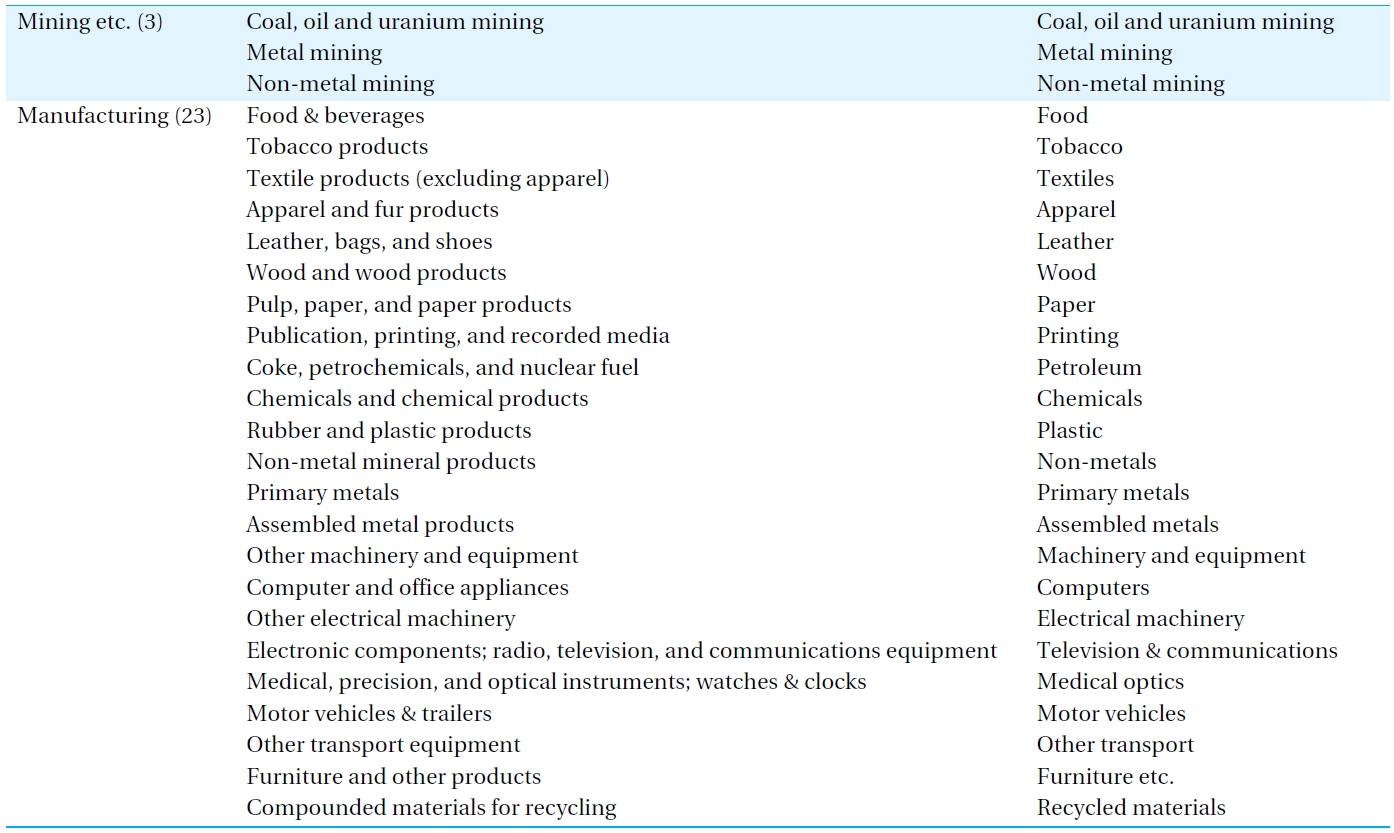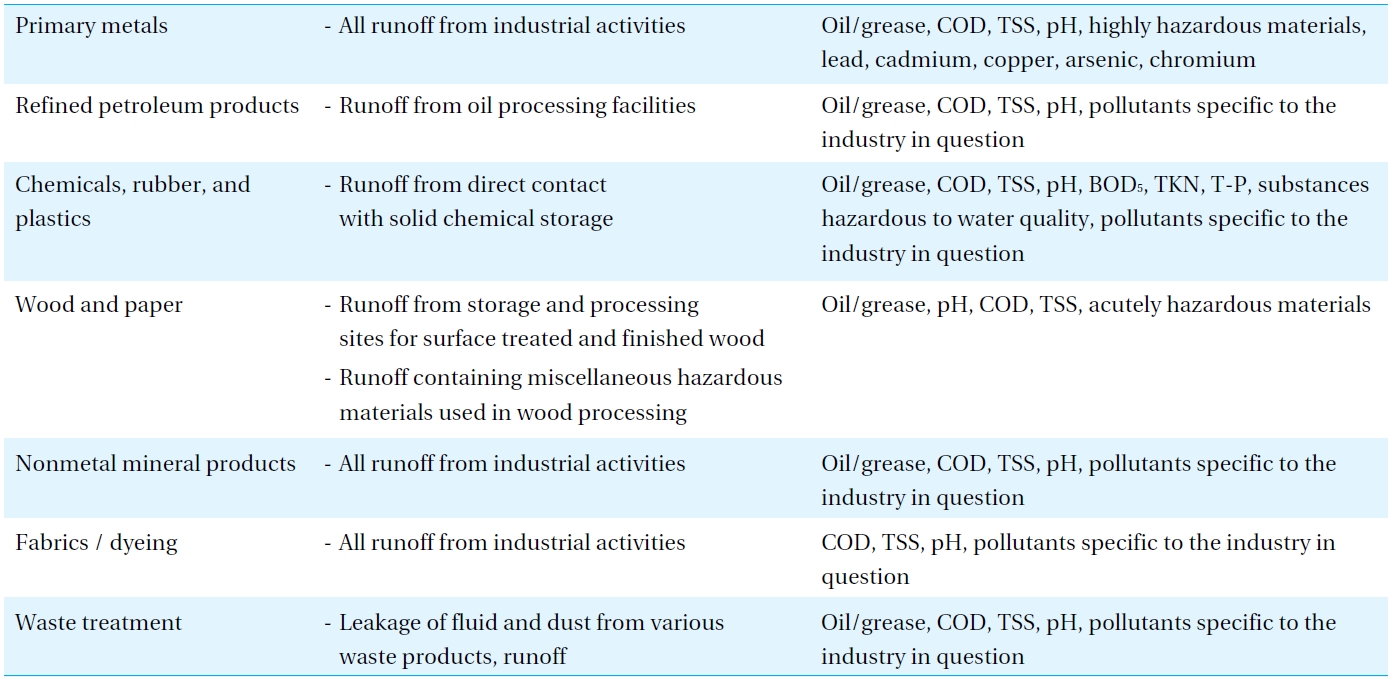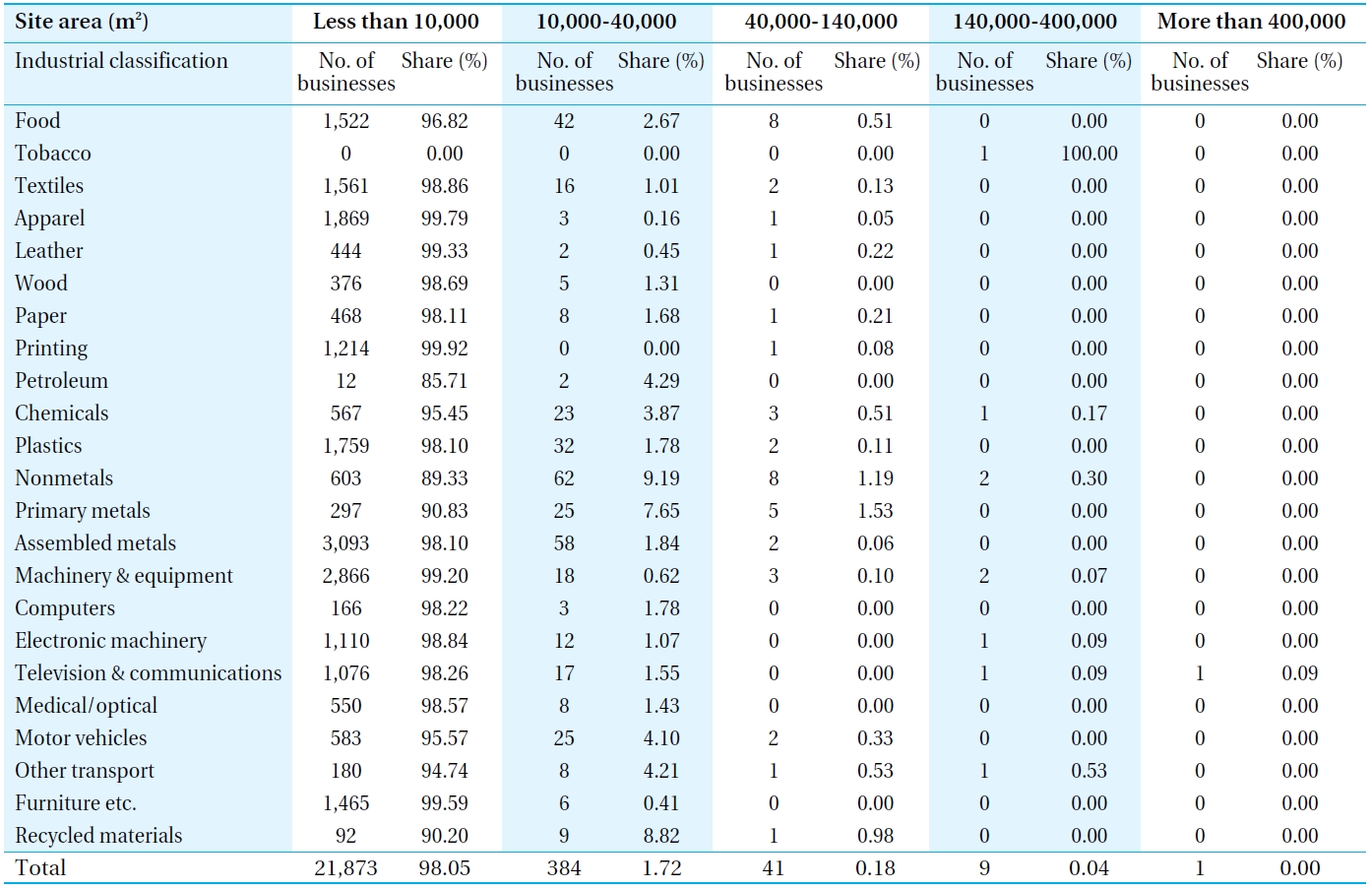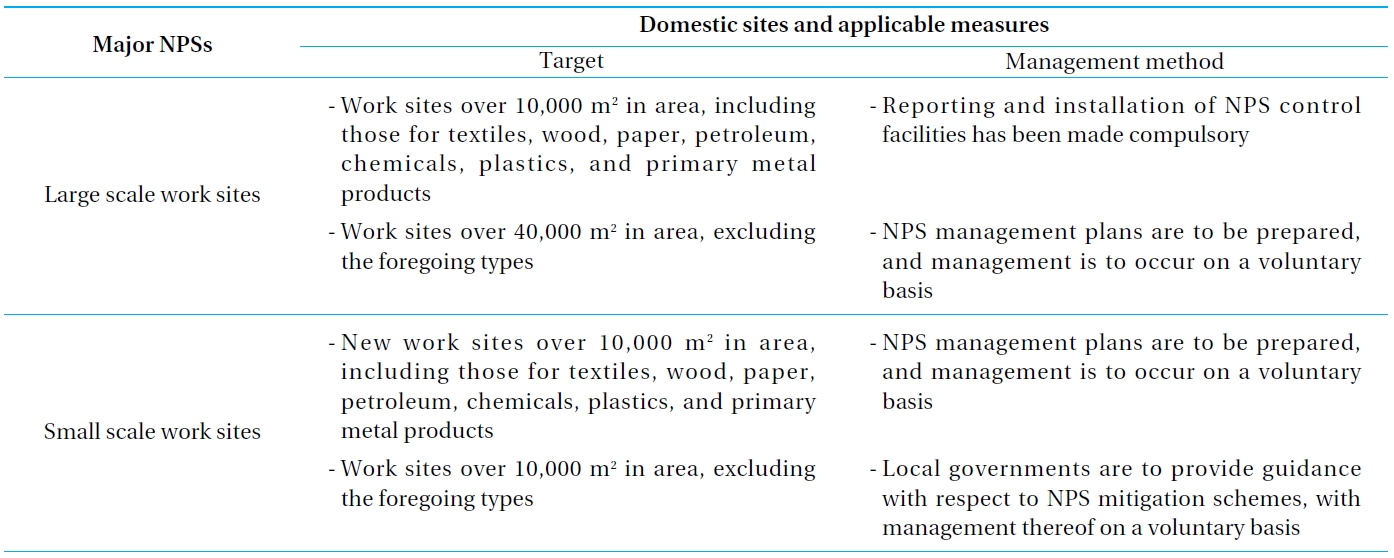



In March, 2004, the "Comprehensive Measures on Nonpoint Pollution Source Management for the 4 Major Rivers" were established by the relevant authorities to enhance the "Comprehensive Measures on Water Quality Management" and to develop governmental measures on nonpoint sources (NPS) by 2020[1]. However, the results have been limited due to inadequate legal and institutional systems for NPS management; particularly, the lack of any means to manage businesses and construction sites that discharge runoff where the pollution levels exceed permissible water quality standards. Because NPS management is most efficient when managed at its source, the active participation of all stakeholders is required, including the authorities, private developers, and manufacturers.
Therefore, a reporting system for the installation of NPS facilities and for business and construction sites (begun in March 2006) was introduced to prepare the legal grounds for promoting the government policy. The reporting and installation system for NPS management requires construction sites already subject to environmental assessments, as well as businesses that can potentially discharge wastewater from NPS, to install control facilities. Accordingly, this study was intended to suggest the industries that should be subject to NPS management measures pursuant to changes in the law, as well as the appropriate scope and extent of such management.
Up to the present, pollutant sources have been categorized as "wastewater discharging facilities" (accounting for 82 industries typed by process, including "coal" and "mining") and as "other water quality pollutant sources" (accounting for five industries, including "aquaculture facilities" and "golf courses")[2]. Nonpoint sources discharged with rainwater have not been adequately addressed. Fortunately, since March 2006, nonpoint pollutant discharging facilities have been compelled to report on their NPS management, and to install appropriate control systems. Accordingly, this study was enacted to discern what types of facilities should be subject to management measures due to excessive discharges of nonpoint pollutants.
2. Selection of Industries Subject to NPS Management
A number of recent domestic and foreign studies have found a large number of cases where concentrations of pollutants in runoff discharged from raw materials stored outdoors, as well as from waste materials left on the roadside, exceeded limits set for wastewater discharging facilities; thus, constituting major release points for hazardous materials[2-4]. Accordingly, research is needed on what kind of NPS facilities should be subject to increased regulation, as well as what levels of pollution constitute grounds for such regulation.
[Table 1.] Industrial classification

Industrial classification
[Table 2.] Designation of industries subject to regulation

Designation of industries subject to regulation
Industries that discharge significant amounts of nonpoint pollution include wood, paper, chemicals, petroleum, coal, metal, leather, stone, clay and glass manufacturing, as well as mining, hazardous waste, landfill, recycling, thermal power, transportation and environmental treatment[2].
As NPS management is still in its infancy, it is desirable at the outset to minimize the scope of industries subject to NPS management measures. Accordingly, it is appropriate that business sites subject to the management targets are those newly established in industries deemed problematic (e.g. steel, textile dyes) and operating over a prescribed scale. In order to select the industries and applicable size of businesses subject to NPS measures, this study used industrial classifications based on the Comprehensive Survey on Industry. These industries are shown in Table 1[5].
Among the industries in Table 1, major NPS dischargers include primary metals, petroleum, chemicals, rubber, plastic, wood, paper, nonmetals, textiles and waste treatment/disposal industries (Table 2). The main pollutants generated by the industries are shown in Table 3. Accordingly, it is appropriate that new business sites in the foregoing industries found to be discharging excessive nonpoint pollutants provide reports on how these will be managed, and for existing businesses to establish and execute voluntary NPS management plans. NPS management requirements will be expanded to all such businesses over the long term.
[Table 3.] Main pollutants generated by each industry

Main pollutants generated by each industry
[Table 4.] Wastewater discharge amounts by land area

Wastewater discharge amounts by land area
3. Estimation of Management Scale for the Application of NPS Measures
As per the aforementioned, it was decided that the scope of industries subject to regulation would be expanded gradually, and that as an initial stage of this process, facilities over a certain size and scale wishing to install new plants would be compelled to install runoff control facilities. In order to expand measures to existing facilities over the long term, new and existing businesses were reviewed simultaneously. To this end, the number of companies subject to NPS measures was determined according to the area of their work sites. The most recent Comprehensive Survey on Industries was published in 2003, and divided the economy into two main categories, "mining" and "manufacturing," and thereafter into categories, subcategories, sub-sub categories, and micro-categories. In this study, a land area analysis was conducted on 23 categories, i.e. industries, in manufacturing (excluding mining), where the land area was not indicated.
The land areas for the sites in 23 industries were classified by size; from 1) less than 10,000 m2, 2) 10,000-40,000 m2, 3) 40,000- 140,000 m2, 4) 140,000-400,000 m2, and 5) over 400,000 m2. The numbers and shares of businesses corresponding to the above areas were also analyzed. The aforementioned land areas were then compared against four classes devised in accordance with the runoff released during the first 5 mm of rainfall. In Class 4; for example, 50 tons of runoff are generated during the initial 5 mm of rainfall on a site with an area of 10,000 m2. The amount of wastewater discharged by land area is shown in Table 4.
3.1. Determination of the Number of Eligible Businesses
An analysis of newly established business sites was performed in 2003. At present, there has been no aggregate survey on the site area of work sites other than data maintained by the National Statistical Office[5]. Moreover, the data retained by the National Statistical Office, with respect to the date of establishment, has not undergone internal review, indicating a low level of reliability. Accordingly, other methods were deployed that used identification numbers for each business. Identification numbers for 2002 and 2003, the most recent years for which data were available, were collected from the National Statistical Office, with businesses started in 2003 further categorized. A total of 21,873 businesses were deemed suitable for the analysis (Table 5).
[Table 5.] Number of businesses by land area and industry

Number of businesses by land area and industry
[Table 6.] Work sites subject to NPS management measures and relevant measures

Work sites subject to NPS management measures and relevant measures
3.2. Determination of Management Scale
Newly established work sites categorized as excessive nonpoint pollutant dischargers will be compelled to submit a report on NPS management and install appropriate mitigation facilities. Businesses that exceed the allowed amount of runoff discharges for Class 4 were designated as being subject to NPS management measures. Although such measures currently apply to newly and recently established work sites, such measures will also be expanded to pre-existing work sites over the long term.
Furthermore, as NPS are generated during rainfall, sites subject to NPS measures should not be restricted to the pollutant discharging facilities, but should target the entirety of the work site, as runoff is generated throughout the entire area whenever rain falls. For example, for a 10,000 m2 site, 50 tons of runoff is generated, corresponding to Class 4 wastewater discharge, in the first 5mm of rainfall. The number of industries falling under this category is delineated in Table 5.
Business sites in all classes having a land area over 10,000 m2, with wastewater discharging facilities installed, are compelled to prepare an NPS management plan and to voluntarily manage and install NPS management facilities.
In 2004, the Korean government launched comprehensive measures for nonpoint pollution, which were intended to reduce their amount by 34.3% over of those forecast by 2020. During the first and second stages, from 2004 to 2011, NPS mitigation measures have focused on systemic improvements and project management, as well as the introduction of optimal management techniques; accordingly, reductions have been small. However, during the third stage in 2011, serious reductions will be pursued. Accordingly, the gradual expansion of sites subject to NPS measures has focused on the establishment of a basis for reduction measures in connection with model projects during the first half of the plan, with full scale enforcement due in the second half. Legal and institutional improvements should be prepared, with government support, in the first half of the plan, with an emphasis on voluntary achievement of targets rather than compulsory enforcement. After 2011, when the institutions are in place, legal grounds should be created to induce full reduction through the active installation of reduction facilities.
As nonpoint pollutants are discharged regardless of the presence of wastewater discharging facilities, it is desirable to expand enforcement to all industries over the long-term. Major nonpoint dischargers include hazardous waste landfills, transport related facilities (cargo terminals, passenger terminals, etc), recycling facilities and environmental treatment facilities. While most of these facilities have relatively low amounts of wastewater discharges, they can be significant sources of nonpoint pollution if not properly managed. Industrial and manufacturing facilities, outdoor storage areas and waste storage facilities exposed to rainfall are particular problems. For Korea, rather than commencing NPS management en masse, it has been more appropriate to gradate NPS management into stages tailored to the different needs of new and existing businesses, as well as to the needs of large and small scale businesses in consideration of their specific circumstances. This has allowed sufficient time for such businesses to become accustomed to the concept of NPS management.
The authors wish to thank the Korea Environment Institute for their support in carrying out this project.





